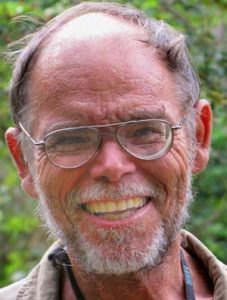b. 1947
The University of North Carolina at Chapel Hill Herbarium (NCU) has cataloged approximately 60 vascular plant specimens collected by Jim Conrad. As NCU continues to catalog its collections it is likely that more specimens collected by Conrad will be found. All specimens found to date were collected in Kentucky and many are noted as vouchers for “The Vascular Flora of McLean Co., Western Ky. Coalfields Region”.
Other herbaria curating vascular plant specimens collected by Jim Conrad include Austin Peay State University (APSC), Berea College (BEREA), Botanical Research Institute of Texas (BRIT), California Botanic Garden (CalBG:RSA), Eastern Kentucky University (EKY), Iowa State University (ISC), University of Texas at Austin (LL and TEX), Missouri Botanical Garden (MO), North Carolina State University (NCSC), San Diego Natural History Museum (SD), Texas A & M (TAES), University of California, Riverside (UCR), Florida Museum of Natural History (FLAS), University of Kansas (KANU), University of Memphis (MEM), University of Michigan (MICH), University of Minnesota (MIN), University of Northern Colorado (GREE), University of South Florida (USF), University of Tennessee, Knoxville (TENN), University of Wisconsin, Madison (WIS), Valdosta State University (VSC), and Washington State University (WS).1

“I was born in Madisonville, Kentucky and raised on a tobacco farm in western Kentucky, about 100 miles directly north of Nashville, Tennessee,” said Conrad in an interview with Yucatan Adventure in 2009. “I received a Bachelor of Science in Biology and Geology, then my Master of Science in Botany from the University of Kentucky. At first I wanted to major in Zoology, but when they refused to let me draw insects for Entomology instead of kill and collect them, I changed to Botany. After graduate school for three years I worked at the Missouri Botanical Gardens in St. Louis, Missouri. They sent me to collect plants for taxonomic research in several tropical countries. When I saw with my own eyes the vast destruction of the Earth’s biosphere, I felt that I needed to be more actively engaged in trying to protect it. I was naive enough to think that if I could tell people about the destruction, things would happen to stop it. So I quit my job as a botanist and became a freelance writer, which has been my main job throughout my adult life.”2
PUBLICATIONS:
Conrad, Jim (1996) Discover Nature in the Garden: Things to Know and Things to Do (Discover Nature Series). Mechanicsburg, PA: Stackpole Books.
Conrad, Jim (1995) Mexico: A Hiker’s Guide to Mexico’s Natural History. Seattle: Mountaineers.
Conrad, Jim (1992) The Maya Road. Chalfont St. Peter, United Kingdom: Bradt. (in the United States, published in Edison, NJ: Hunter).
SOURCES:
1. SERNEC Data Portal. 2024. http//:sernecportal.org/index.php. Accessed on June 24.
2. Hacienda Chichen interview with Jim Conrad. 2009. http://www.yucatanadventure.com.mx/Jim-Conrad.htm